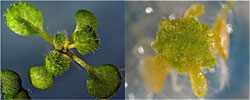How plants self heal

Figure 1: Arabidopsis plants grown without plant hormones. Compared to the wild-type plants (left) those over expressing WIND1 (right) can exhibit a range of developmental abnormalities including dedifferentiated callus-like cells masses instead of roots and shoots. Copyright : 2011 Akira Iwase and Keiko Sugimoto
Many animals and plants regenerate tissues or even whole organs after injury. Typically, specialized cells at the wound site revert to a ‘pluripotent’ state–via a process called dedifferentiation—which means they regain the ability to develop into the various cell types required for regeneration.
The dedifferentiated cells rapidly divide to form a callus from which the damaged tissue or organ will regenerate. Now, a research team from the RIKEN Plant Science Center in Yokohama has identified a master regulator of the response of plants to injury (1).
Developmental biologists have evidence that the mammalian wound response is genetically programmed, involving transcription factors—proteins that regulate gene expression. However, the precise molecular mechanisms underlying the cell dedifferentiation and redifferentiation are poorly understood for both animals and plants, explains team leader Keiko Sugimoto.
Akira Iwase, a senior postdoctoral researcher in Sugimoto’s laboratory, previously identified the transcription factor WIND1 that was expressed in cultured Arabidopsis cells but not in healthy seedlings. His findings suggested that WIND1 might be involved in the wound response. Using transgenic seedlings, Iwase along with Sugimoto and their colleagues have now demonstrated that WIND1 expression increases markedly at wound sites within hours of injury and continues throughout callus development.
Iwase, Sugimoto and colleagues further showed that Arabidopsis seedlings that were genetically engineered to over express WIND1 exhibited a range of developmental abnormalities (Fig. 1). They found that the most severe defects were associated with particularly high levels of WIND1 expression. These included aborted development after germination and the growth of undifferentiated callus-like cell masses at the places where roots or shoots would normally form.
In addition, the researchers found that the callus-like cell masses continued to proliferate rapidly when removed from the plant and grown in culture. This occurred even in the absence in the culture medium of auxin and cytokinin, two plant hormones long known to be involved in the normal regeneration process. Further experiments also confirmed the importance of WIND1 in callus formation in vivo.
The researchers then investigated the mode of action of WIND1. They found that wounding induced a cytokinin response involving increased expression of the so-called ‘B-type Arabidopsis response regulator’ (ARR). Further experiments confirmed that WIND1 acts via the ARR-dependent signaling pathway to promote cell dedifferentiation.
“Our findings clearly demonstrate that WIND1 functions as a key molecular switch triggering cell dedifferentiation in Arabidopsis,” explains Sugimoto. “The discovery of WIND1 should allow us to establish specific role of transcriptional regulators in cell dedifferentiation.”
The corresponding author for this highlight is based at the Cell Function Research Unit, RIKEN Plant Science Center
Journal information
(1) Iwase, A., Mitsuda, N., Koyama, T., Hiratsu, K., Kojima, M., Arai, T., Inoue, Y., Seki, M., Sakakibara, H., Sugimoto, K. & Ohme-Takagi, M. The AP2/ERF transcription factor WIND1 controls cell dedifferentiation in Arabidopsis. Current Biology 21, 508–514 (2011).
Media Contact
All latest news from the category: Life Sciences and Chemistry
Articles and reports from the Life Sciences and chemistry area deal with applied and basic research into modern biology, chemistry and human medicine.
Valuable information can be found on a range of life sciences fields including bacteriology, biochemistry, bionics, bioinformatics, biophysics, biotechnology, genetics, geobotany, human biology, marine biology, microbiology, molecular biology, cellular biology, zoology, bioinorganic chemistry, microchemistry and environmental chemistry.
Newest articles

Properties of new materials for microchips
… can now be measured well. Reseachers of Delft University of Technology demonstrated measuring performance properties of ultrathin silicon membranes. Making ever smaller and more powerful chips requires new ultrathin…

Floating solar’s potential
… to support sustainable development by addressing climate, water, and energy goals holistically. A new study published this week in Nature Energy raises the potential for floating solar photovoltaics (FPV)…

Skyrmions move at record speeds
… a step towards the computing of the future. An international research team led by scientists from the CNRS1 has discovered that the magnetic nanobubbles2 known as skyrmions can be…





















